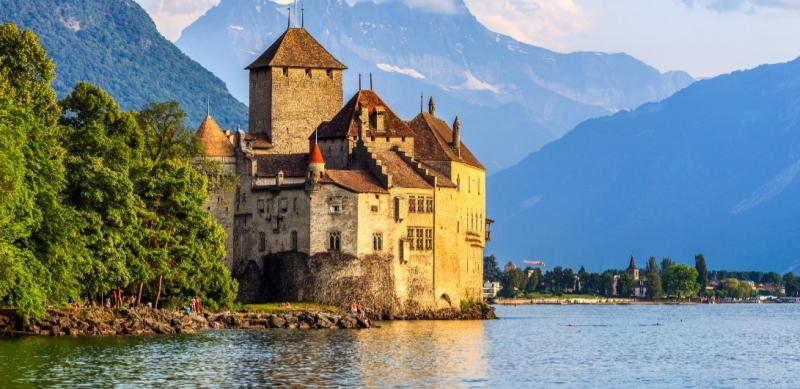
A literary pilgrimage to Lake Geneva
Lake Geneva, Switzerland. June, 1816.
Torrential rain hammers the lake in a cascade of silver spears; thunder growls in the bowels of a shadowy sky; a bitter wind batters through huddles of shivering trees.
This isn’t you’re average rainstorm; it is the legendary ‘year without a summer’ (or so it will be later remembered). Thousands of miles to the east, in what is today Indonesia but was then known as the Dutch East Indies, Mount Tambora still spews colossal funnels of steam and rumbles with sporadic phreatic eruptions. The volcano blew over a year ago, yet the aftermath continues to be endured across the globe, disrupting temperatures and triggering extreme weather from Bengal to New Jersey, Reykjavik to Lake Geneva.
Perched high on the shore of the lake in the Genevan suburb of Cologny, embracing unobstructed views of the raging storm, Villa Diodati stands grand and robust against the elements. Behind its pale, stucco walls and porticoed first floor balcony, a group of unlikely British bohemians bearing troubled souls and bright minds shelter from the weather.
Comprising the company are Villa Diodati’s seasonal tenants: the young and promiscuous poet, Lord Byron, who is fleeing England following a deluge of scandalous accusations, and John Polidori, his personal physician. At the invitation of Lord Byron, his neighbours from an adjacent summer house are also in attendance: the struggling poet Percy Bysshe Shelley, Shelley’s lover and future wife Mary Wollstonecraft Godwin, and Mary’s stepsister Claire Clairmont.
So what does an imaginative party of visionary’s do in the confines of a Swiss villa on what is fast becoming the definition of a dark and stormy night?
They tell ghost stories, of course.
As lightning intermittently illuminates the lake outside, indoors Byron tasks the company with devising their own haunting tale. Bolstered by the free-flow of wine and laudanum, the quiver of firelight up the walls, and the echo of recent conversations on anatomy and the power of nature, some works of literary genius are born: a short story from Polidori entitled, The Vampyre, which will later inspire Bram Stoker’s Dracula, and Mary Shelley’s groundbreaking gothic novel, Frankenstein.
***
Even without the assistance of its usual balmy summer climate, the atmosphere at Lake Geneva in 1816 ignited copious literary inspiration in this group of talented freethinkers. In decades since, the lake has been officially marked on the map as a mecca for creative minds; its timeless alpine allure has seduced the likes of Charlie Chaplin, Audrey Hepburn, David Bowie and Queen – and it’s starkly obvious as to why. A clear summer’s day at Lake Geneva unveils to onlookers an expanse of water like liquid sapphire, and shores tumbling with a spectacle of snaking emerald vineyards, slivers of silky beach, turreted castles, bewitchingly historic towns, and the distant pearly shimmer of the Alps.
An irresistible blend of resplendent landscapes and beguiling medieval history, plus a burgeoning reputation for exquisite wine and gastronomy, unsurprisingly draws more than just inspiration-seeking creatives. Two centuries on from the legendary ‘year without a summer’ and this sublime crescent of water slicing the France-Switzerland border has blossomed into a trendy destination for wealthy vacationers and the world’s rich and famous. In peak season, Lake Geneva is a hip hive of activity as bronzed teens flip and dive off pontoons; flower-fringed promenades weave with walkers, cyclists and runners; and boats operated by exquisitely coiffed couples in Ray Bans glide back to glitzy shore-front mansions.
Yet amid an air of European glamour and a prestige yielded by its celebrity residents, Lake Geneva remains strewn with the same locations frequented by Byron and the Shelley’s in 1816. These age-old sites lure a cult of literary travellers who, fascinated by the events of that turbulent summer 200 years ago, look to retrace the steps of several of English literature’s most esteemed individuals.
Such a journey often begins in Cologny – the leafy wedge of shoreline this group of bohemians temporarily called home. The Cologny of today is one of Geneva’s richest suburbs (think parades of extravagant villas barricaded behind gates, boasting tree-lined driveways studded with sheeny super cars, and hectare upon hectare of gardens baring pools, tennis courts, golf courses and private swathes of woodland). As a primarily residential area it rarely graces a tourist’s itinerary, however, for the handful of literary pilgrims who know of its historical significance it is hallowed ground. Though the Shelley’s modest chalet was long ago demolished, the neighbouring Villa Diodati where Byron and Polidori dwelt for the summer still commands its enviable position overhanging the lake.
Literary tourists have lusted after this luxurious hillside villa for far longer than one may have guessed. Sir Samuel Egerton Brydges – a British writer, genealogist, and contemporary of Byron who spent time in Geneva and wrote books about him after his death – noted that following Byron’s vacating of Villa Diodati in October 1816, ‘the doors of the house were beset by travellers anxious to get a sight of the room in which the poet slept’. Egerton Brydges would no doubt be stunned to know that, two centuries later, visitors from all corners of the globe are still journeying to Cologny with similar intentions. 21st century travellers won’t quite reach the doors of Villa Diodati, however. It remains privately owned and concealed behind manicured hedge rows and lolling trees, though those who know where to stand will snatch a fine view of its green shuttered windows and wrought iron balcony through the trees.
Even from afar you can imagine Byron peering through one of the windows to the lake below, at what Mary Shelley described that summer as ‘an almost perpetual rain’. The lake views that transfixed the party of 1816 have altered little, and are obviously enjoyed by modern day travellers in decidedly calmer conditions than those documented by Mary Shelley. She wrote of the storms in poetic detail: they ‘are grander and more terrific than I have ever seen before. We watch them as they approach from the opposite side of the lake, observing the lightning play among the clouds […] and dart in jagged figures upon the piny heights of Jura’. Her novel, Frankenstein, born out of these evocative tempests, is predictably peppered with similar language.
Transformative as such freak meteorological episodes would prove to the future English literary canon, they did eventually subside, permitting Lord Byron and Percy Shelley to take to the lake’s glassy waters for a literary pilgrimage of their own kind. Inspired by Jean-Jacques Rousseau’s 1761 novel Julie, the pair spent a week sailing the lake and unearthing the novel’s locales, including Vevey (the home of Charlie Chaplin in his final days), and Montreux, a bay town cradled in ribbons of vineyard and pressed with mountain views.
Proving most rousing was Château de Chillon, a striking 13th century fortress dominating a rocky islet on the shore. Thrusting from Lake Geneva’s electric blue waters, the castle’s chunky stone walls and conical turrets are a divergent image to behold, emanating both fairy-tale whimsy and medieval robustness in equal measure. As a Romantic escaping the onset of industrialisation in Britain, this historic edifice struck Byron with a transcendent awe, and in a letter written on 27 June 1816, he noted that he could muster no words to describe the castle for they would only ‘fall short’. Though unable to communicate its exterior magnificence, a descent into the dungeons did stir words within him, and just days after the visit Byron composed The Prisoner of Chillon – a moving poem chronicling the political imprisonment of François Bonivard. The mesmerising beauty of the castle also lent subtler inspiration to Shelley, who wrote the famous poem Hymn to Intellectual Beauty that summer. However, it was Byron’s work which ultimately enjoyed a lasting effect. His poem propelled Château de Chillon into a new era of fame, and inspired another literary pilgrimage decades later, made by the American author Henry James who staged scenes of his 1879 novel, Daisy Miller, at the castle.
Today, Byron’s connection to Château de Chillon enhances its status as one of the most visited historic sites in Switzerland. Behind its impenetrable walls and gothic windows lies an ancient labyrinth of cobbled courtyards, fading murals, sweeping stone archways and intricately carved furnishings, promising to detain visitors for hours in their captivating grasp. It is from afar, however, that the castle is at its most magnificent. Turreted layers of stone the colour of old parchment, topped with a fluttering Swiss flag, cut a storybook figure against a sloping backdrop of dark, dense forest, and behind that, the chiselled outline of the snow-blown Alps.
A sudden spell of bad weather soon drove the pair from these imposing shores to Ouchy: a port in the south of Lausanne. Sprawling across three hillsides, Lausanne is Lake Geneva’s second largest city where warrens of hairpin alleyways are fringed with clutters of cafés and boutiques, and modern architecture pales beside entrancing medieval structures – of which a towering 12th century gothic cathedral is the crowning glory. Haloing Lausanne are stretches of neatly windrowing vineyards, whilst across the cerulean waters on the opposite shore looms the snow-marbled chain of the Savoy Alps. It is picturesque to say the least, and in late June 1816, from their rooms in Ouchy’s shorefront Hôtel de l’Ancre, Shelley and Byron scribbled down their Château de Chillon-inspired poems.
Though Hôtel de l’Ancre no longer exists, in its place rises the grandiose expanse of Hotel d’Angleterre on whose sandy stone walls is a marble plaque commemorating that it was on this site Byron penned The Prisoner of Chillon. Hailed as one of Europe’s most exquisite boutique hotels, Hotel d’Angleterre boasts opulently decorated rooms and vast views over the lake, making it a luxurious choice for any literary pilgrims searching for a truly deluxe experience; alternatively, the plaque is free to enjoy for passers-by, as are the very shorefront views once gazed upon by Byron and Shelley.
From Cologny, to Château de Chillon, to Lausanne, Lake Geneva’s shores and surrounds spawned abundant literature in the summer of 1816, however, the writers also ventured into the heart of the Alps for one final scoop of inspiration. The scale and majesty of the landscapes were like nothing they had encountered before, and twanged at the thread of Romantic thought demanding a deep appreciation of the beauties in nature.
In late July, beneath a welcome azure sky, Percy, Mary and Claire commenced a journey to the valley of Chamonix, winding over stone bridge and babbling stream, along chasms and through sleepy alpine towns, where they were greeted with a glut of waterfalls, forests, orchards and craggy summits. Percy Shelley wrote of such scenes with an otherworldly admiration. On reaching Mont Blanc and the Chamonix valley, he described what he saw with overwhelming wonder: ‘I never imagined what mountains were before. The immensity of these aerial summits excited, when they suddenly burst upon the sight, a sentiment of extatic wonder, not unallied to madness’. Percy Shelley was profoundly affected by the Alps which triggered in him what he identified as an ‘undisciplined overflowing of the soul’. It was in this emotional state in the Chamonix valley thathe composed his famous poem Mont Blanc – an ode that emerged from a desire to ‘imitate the untameable wilderness and inaccessibility solemnity’ of his surroundings.
Such phenomenal landscapes also enthused Mary Shelley who had beheld ‘the snowy Alps’ and ‘the majestic Mont Blanc’ with distant admiration and curiosity eight weeks prior from the French-Swiss border. In Frankenstein, Mary’s protagonist Victor flees to Chamonix in search of peace and restoration, meeting his monster for a dramatic confrontation on the Montanvert glacier (now known as Mer de Glace) which had mesmerised the party of Romantics. Colouring her prose is language of a similar intensity to that found in her and Percy’s journals from their time in the Alps – evidence of the extent to which these environs shaped her work.
The Chamonix valley drew barely 2,000 visitors a year during the early 19th century; yet those who made the venture were rewarded with gloriously unspoiled landscapes and a population consisting of largely farmers and mountain goats. Today, Chamonix is rather less peaceful. A town of 10,000 spills along the valley floor, and five ski resorts emboss its plummeting mountainsides drawing hordes of visitors each winter. Summer is no different as the valley slips on a verdant garb and
welcomes outdoor enthusiasts for hiking, climbing, biking, golfing and white water sports. 130,000 tourists and seasonaires flock to Chamonix in the average year – a wholly different atmosphere to the one Percy Shelley experienced. The scenery is, nevertheless, as dramatic and arresting as it was two centuries ago and literary travellers can hop on a train from Vevey to Martigny before taking the Mont Blanc Express deep into the heart of the Chamonix valley for a full immersion in the landscapes that so inspired these writers.
The Shelley’s gallivant into the Alps drew their summer on the continent to a memorable close, and Byron himself departed Villa Diodati for Italy not long after – leaving behind a legacy not even he (the most self-assured of individuals) could have imagined. Despite the historically unfortunate weather of 1816, Lake Geneva’s remarkable alpine scenery and surrounds had offered Lord Byron and the Shelley’s a setting unlike anything found in the British Isles. Being confronted with nature (and weather for that matter) on such a grand scale overwhelmed their Romantic mind-sets, stirred their emotions, and produced unfettered intellectual responses that would prove incomparably fruitful to the English poetry canon and the gothic genre.
Whilst it was a season of immense productivity, the group’s time in Switzerland was also one of immense happiness. By 1824, Lord Byron, Percy Shelley and John Polidori were all dead, and Mary and Claire were left recalling bygone days at the lake with a solemn nostalgia. The summer that inspired in the company such genius was slipping into myth – but one that would captivate the imagination of future generations for decades to come.
Share this article:




















